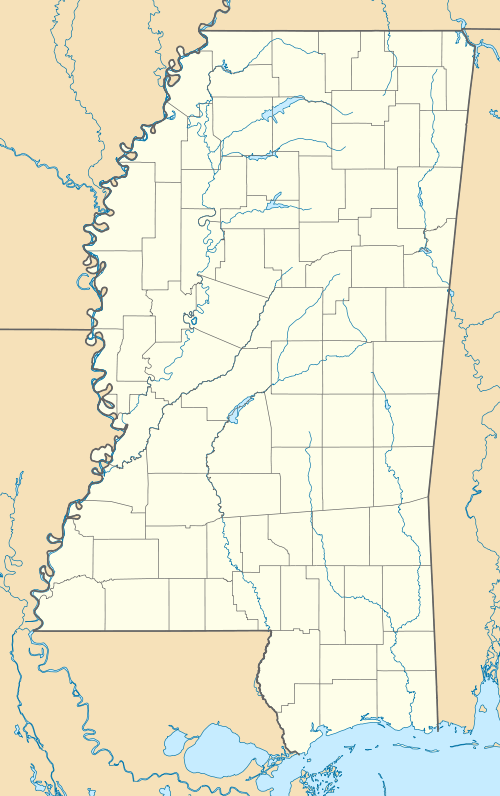Middleton, Mississippi
| Middleton, Mississippi | |
|---|---|
| Ghost town | |
 Middleton, Mississippi | |
| Coordinates: 33°29′10″N 89°45′03″W / 33.48611°N 89.75083°WCoordinates: 33°29′10″N 89°45′03″W / 33.48611°N 89.75083°W | |
| Country | United States |
| State | Mississippi |
| County | Montgomery |
| Elevation | 436 ft (133 m) |
| Time zone | Central (CST) (UTC-6) |
| • Summer (DST) | CDT (UTC-5) |
| GNIS feature ID | 683319[1] |
Middleton is a ghost town in Montgomery County, Mississippi, United States.[1]
Originally located in Carroll County, Middleton was one of its earliest settlements.[2] Once a thriving commercial and educational center, little remains of the original settlement but a cemetery.
History
The first non-Native to settle at this site was Irelton C. DeVane, who in 1790 built a small log store used for trading with the Native people and with the occasional traveler.[3] Other settlers included William Pace and his wife, who came from Kentucky in the 1820s.
Mail was sent from the community by stagecoach as early as 1824.[3]
Following the Treaty of Dancing Rabbit Creek in 1830, and the subsequent removal of the Native Americans from the area, many new settlers began to arrive. The "Little Log Store", located at the junction of the Carrollton and Shongalo roads, became a well-known trading post.[3]
The town was originally incorporated in 1837 as "Irwin", but was changed to Middleton in 1840. Unofficial names included "Oxford" and "Bowling Green".[3]
Several businesses opened during the 1830s, included two general merchandise stores, two doctors offices, a tavern, a furniture maker, a shoe factory, a large store called "The Big Store", a tailor, and a clock shop. Middleton's businesses were located around a town square, and the town had Baptist, Methodist, Presbyterian and Christian churches.[3]
By 1840, Middleton's population had grown to 2,900.
A newspaper called The Family Organ began publishing in 1843. Later businesses included The Middleton Hotel, a photographers shop, a blacksmith shop, a carriage factory, and law offices. On the outskirts of the town were a wool mill, flour mill, cotton mill, leather tannery, and cotton factory. A stage coach ran from Holly Springs to Durant by way of Middleton.
The Middleton Cemetery is one of the oldest in the country, and was built with a deep ditch around it resembling a moat.[3] In 1992, the Winona Lion's Club restored the cemetery and many of its markers.[2][4]
Two well-regarded private schools were established in Middleton. The Judson Institute was a female academy, and The Peoples Academy was a boys school.[3]
Middleton was one of seven locations selected in 1841 as a possible site for the University of Mississippi, and it was also considered as a site for the Mississippi capitol.[3]
Decline
In 1859, the Mississippi Central Railway (later Illinois Central) completed a rail line through Winona, located 1.5 mi (2.4 km) east.[5] As a result, Middleton was abandoned in favor of the new railway town of Winona. Many of Middleton's business and residents relocated there, though some families moved back to Tennessee and Kentucky, or to nearby Carrollton.[3]
Civil War
During the Civil War, Confederate soldiers used many of the old town's mills to manufacture products for their army.[3] As well, Benjamin Grierson and about 1,000 Union soldiers camped near Old Middleton before traveling to nearby Vaiden on January 1, 1863, where they plundered the town.[6]
References
- 1 2 "Middleton". Geographic Names Information System. United States Geological Survey.
- 1 2 Wiltshire, Betty (Winter 2002). "Middleton Cemetery". Carroll County, MS Genealogy Society Quarterly Newsletter.
- 1 2 3 4 5 6 7 8 9 10 "Middleton History". Vaiden.net. Retrieved March 2014.
- ↑ "Irwin and Middleton". Vaiden.net. Retrieved March 2014.
- ↑ Howe, Tony. "Winona, Mississippi". Mississippi Rails. Retrieved March 2014.
- ↑ "Early County Settlements of Carroll County, Mississippi". MSGenWeb. Retrieved March 2014.
| |||||||||||||||||||||||||
